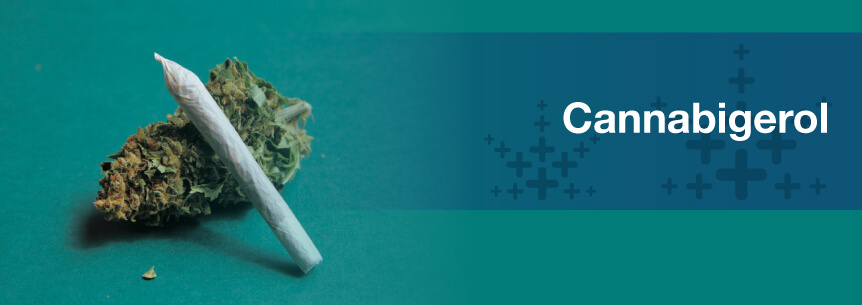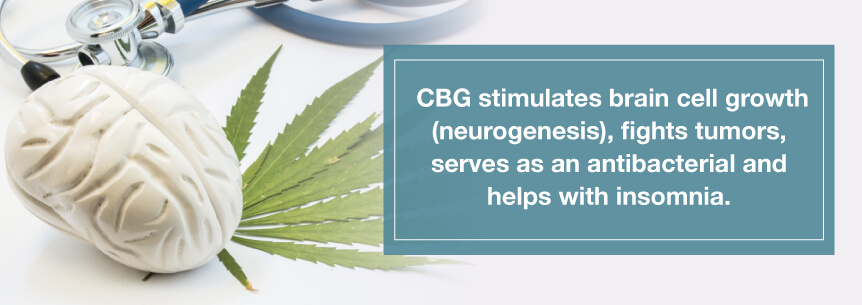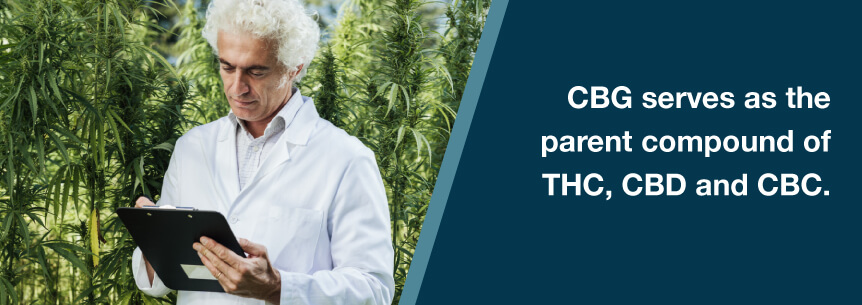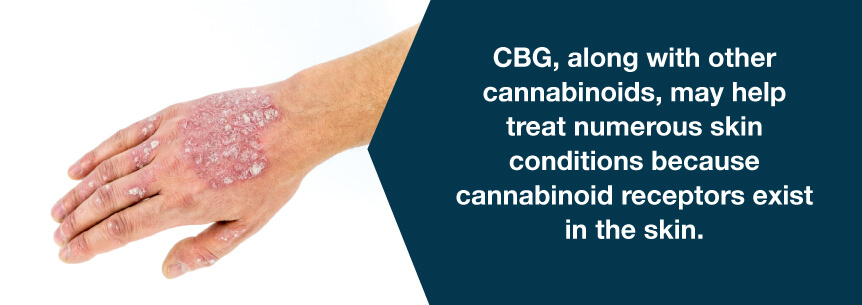
The marijuana plant has more than 85 compounds called cannabinoids that provide the health benefits we associate with medicinal cannabis. Studying each one lets us understand how we can use medical marijuana to help patients. One of these cannabinoids is called cannabigerol (CBG).
Cannabigerol (CBG) is a cannabinoid found in hemp. CBG doesn’t produce the high associated with cannabis — that is due to tetrahydrocannabinol (THC). CBG is said to block the psychoactive effects and the metabolic action of THC. CBG stimulates brain cell growth (neurogenesis), fights tumors, serves as an antibacterial and helps with insomnia.

Most recreational and medical strains of weed have small amounts of CBG — typically between 0.1 and one percent.
There’s very little literature on this cannabinoid, and experts rarely measure it in industrial hemp strains. However, there seems to be around a 0.2 to two percent range. There’s a likelihood of interrupting the enzyme activity converting CBG into THC particularly. Strains containing more CBG (around two to three percent) have started appearing in Europe, and these new mixes should hit the market in 2019 or so.
Cultivators interested in producing CBG-rich medical weed strains may try to extract CBG from six-week-old plants to experiment with crossbreeding and come up with a high CBG strain. CBG is an essential cannabinoid due to its various health benefits, particularly for individuals with conditions affecting their central nervous system, such as:
An interesting aspect of the war against drugs has been the struggle of keeping THC out of individuals’ reach, mainly due to its psychoactive effects. But, as more research goes into medical cannabis and shows its chemical compounds by themselves are providing significant therapeutic value, arguments are continuing to get weaker.
As mentioned, CBG doesn’t cause psychoactive effects like THC — meaning you won’t get high from it. But, it could help balance THC’s effects, as well as the effects of other cannabinoids since it promotes synergy. It may also affect your body directly in various ways.
All cannabinoids interact with cannabinoid receptors found in your body. CBG acts on both your CB1 and CB2 receptors as a partial agonist. But, CBG’s effect on these receptors is relatively weak when you compare it with THC’s. CBG may also increase your body’s anandamide levels. Your body’s anandamide is a cannabinoid occurring naturally in your body and helping to regulate various biological functions like:
Anandamide, like THC, also acts on your CB1 and CB2 receptors, which produce its effects.
CBG additionally hinders the uptake of gamma-aminobutyric acid (GABA), which is the brain chemical responsible for regulating neuron activity. CBG’s effect on GABA uptake is more significant than both CBD and THC.
CBG can balance your fight or flight response. To put it technically, CBG has a moderate affinity 5-HT1A receptor antagonist, a high-affinity a2-adrenergic receptor agonist and a low-affinity CB1 receptor antagonist and binds to your CB2 receptor, although not many people clearly understand its action just yet.
CBG’s possible balance of the a2-adrenergic receptor signifies the following potential actions:
Aside from all of this, CBG also blocks serotonin receptors, suggesting it’s useful for treating depression. Because it acts on your central nervous system without producing a high, its potential medical uses and benefits are attracting substantial interest.
Advocates of medical weed often praise it as being a miracle cure, while prohibitionists claim it is dangerous. In actuality, many cannabinoids are present in cannabis, which provide patients with therapeutic relief and adapt seamlessly into the endocannabinoid receptors of your:
While there’s not a lot of research, some recent studies suggest cannabinoids interact in an incredibly complex, specialized manner, creating balance (homeostasis) and synergy that depends not only on their exact ratios but also on the current cannabinoids. However, researchers place a great deal of focus on marijuana’s two primary cannabinoids — CBD and THC.
Numerous states are considering or have already passed limited laws allowing patients to use weed products that are high in CBD and contain little to no THC. However, there’s not much mention of the other cannabinoids. With many of them identified but little knowledge about them, people are in the dark as far as what medical relief the lesser-known cannabinoids may provide.
Because of how CBG interacts with your brain’s endocannabinoid receptors, it’s thought that the cannabinoid could counteract the paranoia some high-THC strains can cause in some patients. CBG could act as a buffer, enabling individuals to consume treatment that would otherwise create an incapacitating psychological side effect. Also, CBG seems to work similarly to CBD by:
What’s materialized today is the following knowledge and understanding of cannabinoids and the human body. The body’s endocannabinoid system seems to be a primary regulatory system. Its makeup maintains balance or homeostasis of the normal function of the body system and knows how to correct out-of-balance systems. This is the science and “magic” behind cannabinoids.
In fact, our bodies produce their own natural endocannabinoids. But, in sick individuals or those experiencing pain, ingested cannabinoids help make the system work better. You have cannabinoid receptors throughout your body that, when activated with cannabis, will get right to work. This is the reason medical pot seems to be a promising treatment for so many diseases.
Some say CBG has some pain-relieving qualities. Many studies indicate it may have higher efficacy in neuropathic pain than CBD, and others show it could also have some antidepressant effects. Researchers have also studied CBG for its therapeutic effects on certain conditions like:
CBG has the molecular formula C21H32O2, which is similar to THC, but with a different structure. As a phytocannabinoid, it appears naturally in cannabis plants, so you don’t have to look for it in the human body or artificially synthesize it. Marijuana plants with high levels of CBG tend to have small amounts of THC and grow in higher altitudes.
We categorize CBG in the CBG group of cannabinoids, which includes six other compounds: CBGA, CBGV, CBNA, CBNVA, CBGM and CBGAM. These cannabinoids have similar molecular structures. Since we don’t have much research on any of these compounds, we can’t say how similar their effects are to each other.
Although marijuana makes the person using it feel “high,” certain cannabinoids don’t cause this feeling when used on their own. CBG and its relatives don’t have psychoactive properties, so you don’t have to worry about impairment when you take medicine based on it.
While we don’t talk about CBG as much as major cannabinoids like THC and CBD, it’s still essential. In fact, it serves as the parent compound of THC, CBD and CBC. Enzymes in a young cannabis plant break down CBGA or cannabigerolic acid. It then turns into cannabidiolic acid (CBDA), cannabichromene acid (CBCA), or tetrahydrocannabinolic acid (THCA). Once one of the acids get exposed to light or ultraviolet heat, it turns into THC, CBD or CBC.

You can find more CBG in hemp plants and younger marijuana plants. Cultivation companies are currently working on developing strains with higher amounts of CBG. Since medication producers extract CBG from budding marijuana plants during their flowering stage, it’s more difficult to get substantial amounts of CBG compared to major cannabinoids.
Research on CBG’s medicinal properties is still in its preliminary stages and only focuses on animal trials, but the results we’ve found so far are promising. Studies indicate CBG could improve your health by:
While most evidence on the efficacy of CBG comes from pre-clinical research, these studies reveal a vast range of CBG’s potential benefits and uses, including its ability to:

In therapeutic doses, CBG doesn’t have side effects — however, uncontrolled or higher doses could result in side effects. One study found in pre-satiated rats, CBG is a well-tolerated appetite stimulant.
Because CBG is showing so much promise, some seed companies are growing cannabis strains purposefully high in CBG. But, because of the entourage effect — the notion that terpenes and cannabinoids work better together to produce medical efficacy — a lot of marijuana growers also include THC purposefully in the mix.
Doctors and researchers are becoming more aware of how cannabinoids interact synergistically, despite cannabinoid functionality ignorance. Even though isolating certain cannabinoids can help prevent undesirable side effects to some patients, doing so could be a weak strategy overall for patients.
Because of the complex interaction of phytocannabinoids and an individual’s endocannabinoid system, both researchers and breeders need to learn more to be able to deliver the most patients maximum efficacy.
Unfortunately, it’s difficult to come by CBG-rich strains. There isn’t a whole lot of research on it since the demand has been relatively low. However, now that the medical marijuana market is expanding, more individuals are seeking innovative ways weed can help them.
In the meantime, below are a few strains known to have CBG in them:
If we still see research results lining up with what we’ve found so far, CBG could help patients with a wide variety of conditions we already treat with medical marijuana, including:
While CBG again isn’t psychoactive and doesn’t get you high, psychoactivity isn’t the critical factor here. CBG is beginning to reveal itself among the many cannabinoids of the marijuana plant as being a potentially therapeutic compound. While it’s not the cannabinoid for movie-enhancement capabilities, it’s likely a good product to use medicinally.
Even though both of these cannabis compounds are non-psychoactive, some things make them stand apart. One of the more noticeable differences is that CBD doesn’t interact with CB1 or CB2 receptors directly like CBG.
As mentioned earlier, CBG increases anandamide production, which is your body’s primary endocannabinoid. Helping to regulate appetite, sleep and memory, anandamide acts on your CB1 and CB2 receptors. CBD decreases anandamide’s access to transport molecule-acting fatty acids, meaning it slows down the process of the molecule of entering the system.
Researchers, doctors and patients still know a lot more about CBD and THC than CBG. However, its potential is fast becoming a reality. The only issue is many studies have not gotten to the clinical stage yet. And, to confidently conclude CBG’s benefits, there needs to be more research.

Interested in getting concentrated CBG medicine when it becomes available? New patients should work with a marijuana-certified doctor to get an evaluation and ask for their opinion. Patients who already have a medical marijuana card can talk to their dispensary staff about CBG medicine, too.